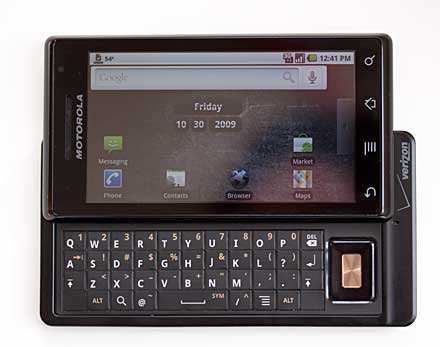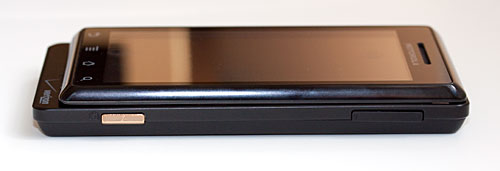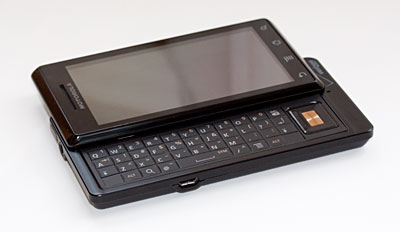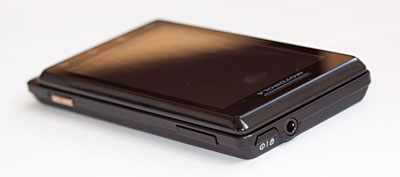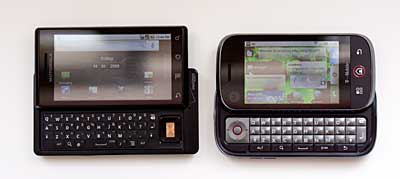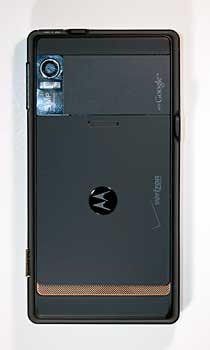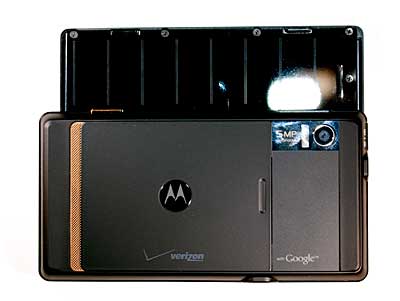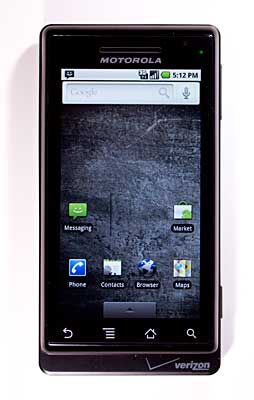 Motorola's in big need of a smashing success and Verizon needs to prop up its line of smartphones: is the Droid by Motorola the answer? Verizon's huge marketing campaign claims so, with the usual anti-iPhone rhetoric (which we could do without) and mysterious bites of the Droid's high end features. Indeed the Droid is a phone to be reckoned with and adds that special sauce to Verizon's recently much improved
Motorola's in big need of a smashing success and Verizon needs to prop up its line of smartphones: is the Droid by Motorola the answer? Verizon's huge marketing campaign claims so, with the usual anti-iPhone rhetoric (which we could do without) and mysterious bites of the Droid's high end features. Indeed the Droid is a phone to be reckoned with and adds that special sauce to Verizon's recently much improved 
Design and Ergonomics
The Droid is a modern minimalist phone, lacking the trademark styling of HTC's Hero or the slim stone look of the Palm Pre. It's a basic rectangle, but it's very slim for a QWERTY slider and it looks like a high class piece. It's solid and well made, and the slider moves with a smooth motion that clicks when opened or closed fully. The battery cover is made of metal with a grippy soft touch finish. The Droid is a phone for sophisticated types and business people, while the Motorola Cliq on T-Mobile is more of a plastic youth messaging device that happens to run Android OS (ver. 1.5). At 6 ounces the phone feels weighty in a good way, and it's in the same size class as the 
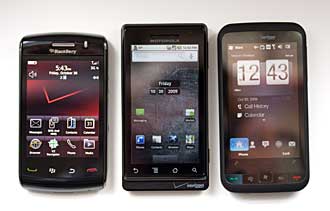 the BlackBerry Storm2, Droid and HTC Imagio (all on Verizon).
the BlackBerry Storm2, Droid and HTC Imagio (all on Verizon). The 3.7" capacitive touch screen dominates the front face with just a small bezel and touch sensitive haptic buttons below. These buttons are: back, menu, home and search. Sorry, there are no hardware call send and end buttons-- you'll need to use the on-screen phone shortcut for that. . . a dangerous proposition if you're on the move and need to keep your eyes ahead of you rather than on your phone. The display is responsive and a pleasure to use, which is true of most Android phones, and it won't leave you longing for an iPhone. Though the resolution is very high at 854 x 480, the OS scales well so text isn't painfully small and images are reasonably sized. The display is very sharp and clear but not as bright and color-rich as the Palm Pre or Samsung's AMOLED display phones like the Moment. It has an auto brightness setting that keeps things on the dim side-- turn it off and manually adjust brightness for a better experience unless battery life is an issue for you. The Droid has an accelerometer that's responsive without being too twitchy and a proximity sensor for calling without cheek-dialing.
The keyboard is surprisingly small since Moto left plenty of room for a not terribly needed d-pad on the right. The size didn't bother us as much as the incredibly short key travel-- the price we pay for a thin phone. Thus typing isn't an absolute joy and the keyboard isn't as useful as the Samsung Moment's, but it's better than on-screen pecking using the default Android keyboard. The black keys are backlit with white masking and are easy to see in the dark, and there are shortcut keys for search and menu and the @ symbol requires no Alt key press.
Video Review
Here's our 10 minute video review of the Droid that includes comparisons with the Samsung Moment and Motorola Cliq Android phones as well as the HTC Imagio Windows 
Phone and Data
The Motorola Droid is a dual band digital CDMA phone that works with Verizon Wireless in the US. It has EV-DO Rev. A for fast data and fallback to 1xRTT. Wifi 802.11b/g is on board when you're not in a good EV-DO coverage area, but keep in mind you must get a data plan with this phone. Google's webkit-based browser (Safari on the iPhone and the Palm Pre browser are also webkit-based) does an excellent job of rendering full HTML sites in desktop fashion. It's also fast at rendering, and thanks to the Droid's very fast CPU, it's as fast as the iPhone 3GS. Flash support should come sometime early next year, but for now the integrated YouTube player that serves mobile versions of YouTube videos does the trick. Videos embedded in web pages such as the one you're reading right now show up in the Android browser, and when you click on the video it opens in the Droid's YouTube player (similar to the iPhone's handling of Flash video). The dedicated YouTube application is standard on all Android phones and offers standard (meh) and high quality (very good) playback options. We had no trouble streaming YouTube video at the high quality setting over Verizon's EVDO Rev. A network with half signal strength (-101 db).
Speaking of signal strength, like many Moto phones, the Droid has excellent reception. Our office is in a Verizon black hole and most phones barely hold onto a bar of 1x and EV. The Droid never dropped EV, always had good data throughput and 1x stayed steady at about 50 to 60% signal strength. If you're in a marginal coverage area, this is the smartphone to get.
Call quality, even with a good signal was OK but not great. Callers said our voice sounded nasal but not underwater. On our end calls were loud and clear but sounded mechanical and digitized. We wouldn't call it bad, just artificial sounding. The speakerphone is uncannily loud. Unless you're at Yankee Stadium during the World Series just after Hideki Matsui hit a homer, you'll have no trouble hearing calls, music and video on this phone. The large speaker grille lives on the back, but we didn't have to turn the phone over to improve volume or quality. The Droid works with Google Voice, Google's calling service that works over data networks rather than Verizon's voice network. You must have a Google Voice account to use this feature, and the service is still running in invite-only mode.
Software and Android OS 2.0
The Droid is a full "with Google" phone which means it hasn't been heavily customized like the "powered by Android" HTC Hero and Moto Cliq. In theory this means the smartphone should be eligible for Google OS updates that are managed by Google and the carrier rather than requiring a customized new OS version created by the manufacturer (Motorola in the Droid's case). It also means vanilla Android, and that's not a bad thing given the operating system's freshness and pleasant UI, but we do long for a bit of that special sauce as with HTC's Sense UI. There's no MOTOBLUR here, and that's likely a good thing for the older and more business-oriented market the phone targets. That doesn't mean you can't social network your heart out. Facebook is pre-installed and in fact integrates with contacts beautifully without creating duplicates. It has a home screen widget so you can keep track of your friends. You can download Twitter clients with and without widgets and a variety of IM clients. Google's own Google Talk is the only pre-installed IM client.
Android OS 2.0 syncs with MS Exchange as well as Google. There's support for syncing to other sources, for example Facebook. MS Exchange syncs calendar and contacts and picks up Exchange email. Android 2.0 still has that strange separation between Gmail and other email; there's a Gmail icon and an Email icon. Likewise SMS/MMS Messaging lives in the Messaging application. If you sync your MS Exchange calendar, that data goes into a separate Corporate Calendar application. HTC's integration on the Hero is tighter and they added syncing over the cable to Outlook in Windows in their customized Android build-- sorry Droid, you're second best.
Media syncing is still nonexistent. Want music or video? Load them onto a microSD card yourself-- there's no mollycoddling iTunes treatment here. The Droid has a decent music player that supports MP3 and non-DRM iTunes AAC format tunes. The Gallery handles video playback with limited format support: basically MPEG4 encoded in H.264 format. Fortunately that's a popular format and the same commonly used to rip content for the iPod and iPhone. Again, thanks to that Cortex A8 CPU, the Droid handled video playback from the microSD card very well. We tested it with a 720 x 360 pixel video encoded at 1,050 kbps and it played perfectly. That's better than the HTC Hero and MyTouch 3G, both of which use and old and dreary 528MHz Qualcomm CPU.
As a business phone, the Droid does a decent job thanks to MS Exchange support but it falls behind Windows Mobile since it lacks an integrated Office suite that can edit and create MS Office documents. You can buy Documents To Go for Android for $15 via the Market if you need to edit and create MS Office documents. Quickoffice 2.0 is included and it can view MS Word, Excel and PDF documents (but not Office 2007 format files ending with .docx or .xlsx). it renders documents beautifully, including those saved as email attachments. PDF documents look great with full support for images. If you want to carry documents on a card for reference, you'll need to install a free file manager from the Market since Quickoffice doesn't have an icon and thus there's no way to access documents.
The Motorola Droid and the Motorola Cliq (T-Mobile) Android phones.
Camera and GPS
The Moto has a very good 5 megapixel autofocus camera with an LED flash. It takes sharp shots, particularly in well lit settings since the flash is overwhelming in dim settings. The camera UI is intuitive and fresh: there's a slider to switch between photo and video mode and a grab handle (a common Android convention) to pull out the drawer of settings. Images and video are saved to the microSD card and there are a wide variety of exposure, effect and quality settings. Our only complaint: autofocus is a tad sluggish.
Video recording is the star and the Droid can record 720 x 480 pixel video at 25fps (there's a lower quality MMS setting too). Video quality very good as long as the lighting is adequate. Dark settings equal blocky video but well lit scenes are natural.
Rare for a Verizon phone, there's no VZ Navigator; in fact the only pre-installed solution is free! Google Maps 2.0 beta is on board and it adds turn-by-turn spoken directions. Google Maps on Android has always been one of the best mapping and POI solutions on the mobile platform, but it lacked spoken directions and for that you had to use a paid service like VZ Navigator or Telenav. Since this is beta, we expect improvements over time, but as per usual with Google, it's a great start. The guidance voice is a speech synthesized female who sounds robotic (somehow appropriate) but intelligible. Though Google's splash screen warns you the service is in beta and it might tell you to turn left into a creek or hop on a ferry, we found its directions logical and sane (and the same as what VZ Navigator would offer). It handled re-routing well but suffered a mini-meltdown when we chose the back entrance to a big box store (the kind that's so big it has entrances on 3 streets). Google Maps wanted us to circle around an adjacent block to get to the front entrance even though it knew we were on a street that formed the perimeter of the store and that we could have simply turned right to enter the parking lot or taken a right turn 100 feet down to reach the main entrance. Bad robot.
Battery
The Droid ships with a 1400 mAh Lithium Ion battery that's user replaceable. For a very large screen EVDO phone with a fast CPU, the Droid had very good battery life, easily lasting a day of moderate to heavy use. In addition to Google cloud services sync we had it check other email accounts at a 15 minute interval during business hours, took a 5 mile trip with the GPS, watched several YouTube videos, surfed the web for an hour total, talked on the phone for 30 minutes total and played music for an hour.
Conclusion
It's hard not to like Moto's new robot. The Droid is a smashing smartphone that gives Verizon's lineup a serious lift. The hardware's look might be polarizing-- folks seem to either love it or hate it, but it's got a clean, modern and slim design. It's well made with one of the nicer slider mechanisms on a phone and that huge display makes you feel like you've got a mini computer disguised as a phone. Reception is excellent and data speeds and web page load times are likewise tops. Android could use some help in the friendly multimedia department with desktop media syncing and more supported video playback formats, but with a little effort the Droid is a very good music player and portable video player (drag them to a card yourself and convert videos to MPEG4 H.264 format first). Unless you have serious business needs that require BlackBerry push email or strong MS Exchange and Office support, the Droid is a top pick among Verizon's smartphones.
Websites: www.verizonwireless.com, www.motorola.com
Price: $199 after rebates with a 2 year contract. $559 with no contract.
Specs:
Display: 3.7" capacitive 16 million color touch screen. Resolution: 480 x 854, supports both portrait and landscape mode, has accelerometer, haptic feedback and a proximity sensor.
Battery: Lithium Ion rechargeable. Battery is user replaceable. 1400 mA. Claimed talk time: 6.4 hours.
Performance: 600MHz ARM Cortex A8 CPU (TI OMAP 3430). 256 megs RAM, 512 megs flash ROM with 250 megs available as internal storage.
Size: 4.56 x 2.36 x 0.54 inches. Weight: 5.96 ounces.
Phone: CDMA dual band digital with EV-DO Rev. A for fast data with fallback to 1xRTT.
Camera: 5 megapixel with autofocus lens and dual LED flash. Shoots video with audio up to 720 x 480 pixels at 24 fps in .3GP format (MMS size video option also available). Max photo resolution: 2592 x 1936 pixels. Has 4x digital zoom.
GPS: Built in aGPS that works with Google Maps.
Audio: Built in stereo speakers, mic and 3.5mm standard stereo headphone jack.
Networking: Integrated WiFi 802.11b/g and Bluetooth 2.1 + EDR supporting headset, handsfree and A2DP stereo. Tethering not yet supported.
Software: Android OS 2.0 (Eclair). Google apps: Gmail, Google Maps, Google Voice Search, Webkit-based web browser, YouTube player and voice dialing. Verizon applications: Visual Voicemail.
Expansion: 1 SDHC microSD card slot, 16 gig card included.


